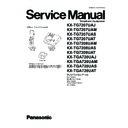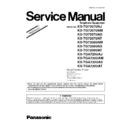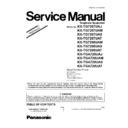Panasonic KX-TG7207UAJ / KX-TG7207UAM / KX-TG7207UAS / KX-TG7207UAT / KX-TG7208UAM / KX-TG7208UAS / KX-TG7208UAT / KX-TGA720UAJ / KX-TGA720UAM / KX-TGA720UAS / KX-TGA720UAT Service Manual ▷ View online
3
KX-TG7207UA/KX-TG7208UA/KX-TGA720UA
TABLE OF CONTENTS
PAGE
PAGE
1 Safety Precautions----------------------------------------------- 4
1.1. For Service Technicians --------------------------------- 4
2 Warning -------------------------------------------------------------- 4
2.1. Battery Caution--------------------------------------------- 4
2.2. About Lead Free Solder (Pbf: Pb free)--------------- 4
2.2. About Lead Free Solder (Pbf: Pb free)--------------- 4
3 Specifications ----------------------------------------------------- 5
4 Technical Descriptions ----------------------------------------- 6
4 Technical Descriptions ----------------------------------------- 6
4.1. Block Diagram (Base Unit) ------------------------------ 6
4.2. Circuit Operation (Base Unit)--------------------------- 7
4.3. Block Diagram (Handset)-------------------------------10
4.4. Circuit Operation (Handset)----------------------------11
4.5. Circuit Operation (Charger Unit) ----------------------12
4.6. Signal Route -----------------------------------------------13
4.2. Circuit Operation (Base Unit)--------------------------- 7
4.3. Block Diagram (Handset)-------------------------------10
4.4. Circuit Operation (Handset)----------------------------11
4.5. Circuit Operation (Charger Unit) ----------------------12
4.6. Signal Route -----------------------------------------------13
5 Location of Controls and Components ------------------14
5.1. Controls -----------------------------------------------------14
6 Installation Instructions ---------------------------------------14
6.1. Connections------------------------------------------------14
6.2. Battery-------------------------------------------------------15
6.2. Battery-------------------------------------------------------15
7 Operation Instructions-----------------------------------------16
7.1. Base Unit Settings----------------------------------------16
7.2. Handset Settings -----------------------------------------17
7.3. Registering a Handset to the Base Unit ------------18
7.4. Dialling Mode (Tone/Pulse) ----------------------------18
7.5. Error Messages -------------------------------------------18
7.6. Troubleshooting-------------------------------------------19
7.7. For Service Hint-------------------------------------------21
7.2. Handset Settings -----------------------------------------17
7.3. Registering a Handset to the Base Unit ------------18
7.4. Dialling Mode (Tone/Pulse) ----------------------------18
7.5. Error Messages -------------------------------------------18
7.6. Troubleshooting-------------------------------------------19
7.7. For Service Hint-------------------------------------------21
8 Service Mode -----------------------------------------------------22
8.1. Engineering Mode ----------------------------------------22
8.2. How to Clear User Setting------------------------------26
8.2. How to Clear User Setting------------------------------26
9 Troubleshooting Guide ----------------------------------------27
9.1. Troubleshooting Flowchart -----------------------------27
9.2. Troubleshooting by Symptom (Base Unit and
9.2. Troubleshooting by Symptom (Base Unit and
Charger Unit) ----------------------------------------------39
9.3. Troubleshooting by Symptom (Handset) -----------42
9.4. How to Replace the Flat Package IC ----------------45
9.4. How to Replace the Flat Package IC ----------------45
10 Disassembly and Assembly Instructions ---------------47
10.1. Disassembly Instructions -------------------------------47
10.2. How to Replace the Handset LCD -------------------50
10.2. How to Replace the Handset LCD -------------------50
11 Measurements and Adjustments---------------------------51
11.1. The Setting Method of JIG (Base Unit) -------------51
11.2. Adjustment Standard (Base Unit)---------------------53
11.3. Adjustment Standard (Charger Unit)-----------------54
11.4. The Setting Method of JIG (Handset) ---------------55
11.5. Adjustment Standard (Handset) ----------------------57
11.6. Things to Do after Replacing IC or X'tal ------------58
11.7. RF Specification-------------------------------------------60
11.8. How to Check the Handset Speaker or
11.2. Adjustment Standard (Base Unit)---------------------53
11.3. Adjustment Standard (Charger Unit)-----------------54
11.4. The Setting Method of JIG (Handset) ---------------55
11.5. Adjustment Standard (Handset) ----------------------57
11.6. Things to Do after Replacing IC or X'tal ------------58
11.7. RF Specification-------------------------------------------60
11.8. How to Check the Handset Speaker or
Receiver ----------------------------------------------------61
11.9. Frequency Table (MHz) ---------------------------------61
12 Schematic Diagram ---------------------------------------------62
12.1. For Schematic Diagram---------------------------------62
12.2. Schematic Diagram (Base Unit) ----------------------64
12.3. Schematic Diagram (Handset) ------------------------66
12.4. Schematic Diagram (Charger Unit) ------------------68
12.2. Schematic Diagram (Base Unit) ----------------------64
12.3. Schematic Diagram (Handset) ------------------------66
12.4. Schematic Diagram (Charger Unit) ------------------68
13 Printed Circuit Board-------------------------------------------69
13.1. Circuit Board (Base Unit) -------------------------------69
13.2. Circuit Board (Handset) ---------------------------------71
13.3. Circuit Board (Charger Unit) ---------------------------73
13.2. Circuit Board (Handset) ---------------------------------71
13.3. Circuit Board (Charger Unit) ---------------------------73
14 Appendix Information of Schematic Diagram--------- 74
14.1. CPU Data (Base Unit) ---------------------------------- 74
14.2. CPU Data (Handset) ------------------------------------ 76
14.3. Terminal Guide of the ICs, Transistors and
14.2. CPU Data (Handset) ------------------------------------ 76
14.3. Terminal Guide of the ICs, Transistors and
Diodes ------------------------------------------------------ 78
15 Exploded View and Replacement Parts List ----------- 79
15.1. Cabinet and Electric Parts (Base Unit) ------------- 79
15.2. Cabinet and Electric Parts (Handset) --------------- 80
15.3. Cabinet and Electric Parts (Charger Unit) --------- 81
15.4. Accessories and Packing Materials ----------------- 82
15.5. Replacement Part List ---------------------------------- 84
15.2. Cabinet and Electric Parts (Handset) --------------- 80
15.3. Cabinet and Electric Parts (Charger Unit) --------- 81
15.4. Accessories and Packing Materials ----------------- 82
15.5. Replacement Part List ---------------------------------- 84
4
KX-TG7207UA/KX-TG7208UA/KX-TGA720UA
1 Safety Precautions
1.1.
For Service Technicians
• Repair service shall be provided in accordance with repair technology information such as service manual so as to pre-
vent fires, injury or electric shock, which can be caused by improper repair work.
1. When repair services are provided, neither the products nor their parts or members shall be remodeled.
2. If a lead wire assembly is supplied as a repair part, the lead wire assembly shall be replaced.
3. FASTON terminals shall be plugged straight in and unplugged straight out.
2. If a lead wire assembly is supplied as a repair part, the lead wire assembly shall be replaced.
3. FASTON terminals shall be plugged straight in and unplugged straight out.
• ICs and LSIs are vulnerable to static electricity.
When repairing, the following precautions will help prevent recurring malfunctions.
1. Cover plastic parts boxes with aluminum foil.
2. Ground the soldering irons.
3. Use a conductive mat on worktable.
4. Do not grasp IC or LSI pins with bare fingers.
2. Ground the soldering irons.
3. Use a conductive mat on worktable.
4. Do not grasp IC or LSI pins with bare fingers.
2 Warning
2.1.
Battery Caution
1. Danger of explosion if battery is incorrectly replaced.
2. Replace only with the same or equivalent type recommended by the manufacturer.
3. Dispose of used batteries according to the manufacture’s Instructions.
2. Replace only with the same or equivalent type recommended by the manufacturer.
3. Dispose of used batteries according to the manufacture’s Instructions.
2.2.
About Lead Free Solder (Pbf: Pb free)
Note:
In the information below, Pb, the symbol for lead in the periodic table of elements, will refer to standard solder or solder that con-
tains lead.
We will use PbF solder when discussing the lead free solder used in our manufacturing process which is made from Tin (Sn),
Silver (Ag), and Copper (Cu).
This model, and others like it, manufactured using lead free solder will have PbF stamped on the PCB. For service and repair
work we suggest using the same type of solder.
tains lead.
We will use PbF solder when discussing the lead free solder used in our manufacturing process which is made from Tin (Sn),
Silver (Ag), and Copper (Cu).
This model, and others like it, manufactured using lead free solder will have PbF stamped on the PCB. For service and repair
work we suggest using the same type of solder.
Caution
• PbF solder has a melting point that is 50
°F ~ 70 °F (30 °C ~ 40 °C) higher than Pb solder. Please use a soldering iron with
temperature control and adjust it to 700
°F ± 20 °F (370 °C ± 10 °C).
• Exercise care while using higher temperature soldering irons.:
Do not heat the PCB for too long time in order to prevent solder splash or damage to the PCB.
• PbF solder will tend to splash if it is heated much higher than its melting point, approximately 1100
°F (600 °C).
• When applying PbF solder to double layered boards, please check the component side for excess which may flow onto the
opposite side (See the figure below).
5
KX-TG7207UA/KX-TG7208UA/KX-TGA720UA
2.2.1.
Suggested PbF Solder
There are several types of PbF solder available commercially. While this product is manufactured using Tin, Silver, and Copper
(Sn+Ag+Cu), you can also use Tin and Copper (Sn+Cu) or Tin, Zinc, and Bismuth (Sn+Zn+Bi). Please check the manufacturer’s
specific instructions for the melting points of their products and any precautions for using their product with other materials.
The following lead free (PbF) solder wire sizes are recommended for service of this product: 0.3 mm, 0.6 mm and 1.0 mm.
(Sn+Ag+Cu), you can also use Tin and Copper (Sn+Cu) or Tin, Zinc, and Bismuth (Sn+Zn+Bi). Please check the manufacturer’s
specific instructions for the melting points of their products and any precautions for using their product with other materials.
The following lead free (PbF) solder wire sizes are recommended for service of this product: 0.3 mm, 0.6 mm and 1.0 mm.
3 Specifications
Note:
• Specifications are subject to change.
Note for Service:
• Operation range: Up to 300 m outdoors, Up to 50 m indoors, depending on condition
• Analog telephone connection: Telephone Line
• Analog telephone connection: Telephone Line
6
KX-TG7207UA/KX-TG7208UA/KX-TGA720UA
4 Technical Descriptions
4.1.
Block Diagram (Base Unit)
KX-TG7207/7208 BLOCK DIA
G
RAM
(BASE UNIT)
Analog
Front
End
To TEL_LINE
A
B
CN1
Bridge
Rect
D3 D3
Hook Switch
Q
4
,Q
5
Audio
Bell/Caller ID
Interface
Charge
Detector
CPU
59
54
61
52
60
56
55
BELL
HOOK
(Optional)
Off-Hook Line Voltage
64 ADCO
A/D
D/A
ADPCM
Codec Filter
DSP
Speech Encoding
BMC
Burst Encoding
RF
Interface
18
19
TXDA
RXDA
21
20
22
SYCL
SYDA
SYEN
ANT1
ANT2
RF Module
18
16
2
31
21
14
13
12
12
13
XTAL
X
1
10.368
MHz
EEPROM
SCL
SDA
6
5
7
To AC Adaptor
CN2
Limit
Resistor
CHARGE
CONTACT
VUNREG
3.3V
Reg.
IC
1
2.5V
Reg.
Q
9
1.8V
Reg.
Q
8
3.3 V
2.5 V
1.8 V
BBIC
IC5
IC7
IC10
Speech Decoding
Burst Decoding




